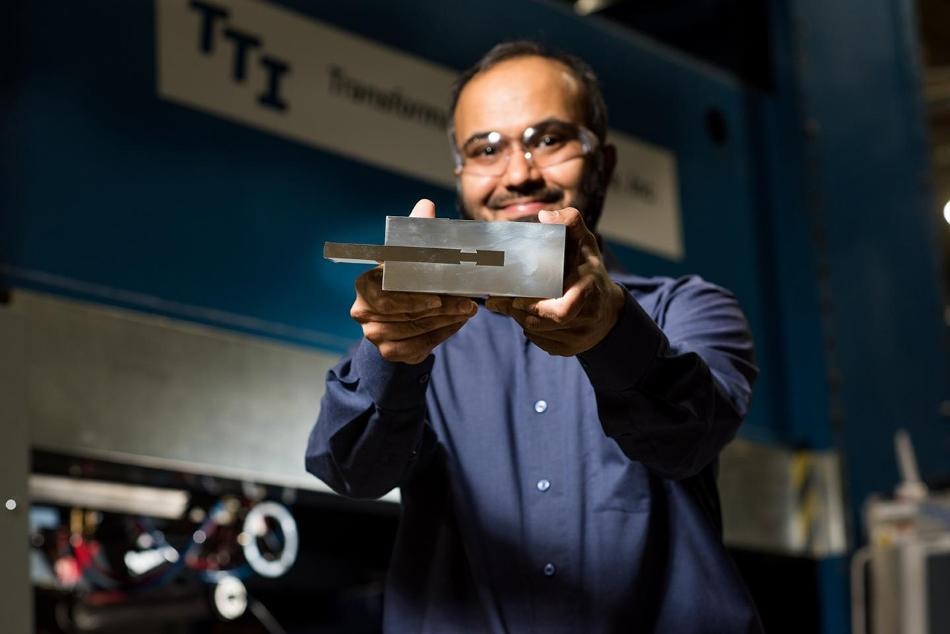Apr 17 2018
An innovative process that welds thick plates of aluminum to steel has been developed and successfully tested by researchers at Pacific Northwest National Laboratory (PNNL). Known as Friction Stir Dovetailing, the novel process will be used for making lighter-weight combat vehicles that are swifter and more fuel efficient.
 Friction Stir Dovetailing is a process that joins thick plates of aluminum to steel. The new process will be used to make lighter-weight military vehicles that are more agile and fuel efficient. (Image credit: PNNL)
Friction Stir Dovetailing is a process that joins thick plates of aluminum to steel. The new process will be used to make lighter-weight military vehicles that are more agile and fuel efficient. (Image credit: PNNL)
The details of the process as well as the testing of joints developed using the novel method are described in the April 15 issue of Scripta Materialia—a peer-reviewed journal that covers original research on the association between the properties and structure of materials.
Lightening the Tank
The military is known to spend several billion dollars on fuel consumption every year, according to the U.S. Government Accountability Office. This cost could be reduced by lowering the weight of aircraft, ships, cargo, and ground vehicles. Therefore, in an effort to reduce fuel costs, maintain the safety of military personnel, and boost operational effectiveness, the U.S. Army Tank Automotive Research Development and Engineering Center, TARDEC in short, introduced a campaign earlier in 2014 to make combat systems - for example, tanks, personnel carriers, and fighting vehicles - more lightweight.
One method that was being investigated by the researchers is the substitution of heavy steel parts with thicker et lighter aluminum. However, steel and aluminum cannot be joined together because their melting points were extremely different. Therefore, the team required a novel process to combine these materials.
TARDEC then teamed up with PNNL, which had earlier devised specialized material joining methods for the automotive sector to develop the new Friction Stir Dovetailing technique. These former methods included Friction Stir Welding that welds similar metals of varying thickness, and Friction Stir Scribe that welds thin sheets of considerably different materials, like steel and aluminum.
While the Friction Stir Scribe technique was able to solve the challenge of welding thin sheets of aluminum with steel, it does not scale up to the thick plates of aluminum - typically measured in inches - required for rugged military vehicles. Aluminum was.
A Technique that Dovetails Nicely with Aluminum and Steel
In woodworking, pieces of wood are joined together by using glue and dovetails. Friction Stir Dovetailing is a similar technique for metals. A mechanical interlock is formed by deforming aluminum into a steel dovetail groove with a specially designed tool. This tool simultaneously forms a thin metallurgical bond - or intermetallic compound - by rubbing along the base of the dovetail. This intermetallic compound "glues" the metals together within the dovetail.
The combination of mechanical interlocking and metallurgical bonding formed during a single process is the innovation that produces joints of superior strength and ductility compared to joints created by the other friction stir methods.
Scott Whalen, PNNL Engineer
The researchers discovered that when complex machine controls are used to accurately regulate pressure and temperature at the aluminum-steel interface, they prevented the growth of intermetallic compounds. During other friction stir techniques, these compounds grow thick and non-uniformly leading to joint brittleness and ultimately failure. However, when intermetallic compounds—iron aluminide or Fe3Al—grow during the Friction Stir Dovetailing method, they prove advantageous to the joints because they are very thin, i.e., one thousand times thinner than a single strand of human hair, which serve as "glue" without causing embrittlement.
Intermetallic compounds will form between aluminum and steel during all friction stir techniques as part of the heating process. We discovered that Friction Stir Dovetailing inhibits intermetallic compound overgrowth because temperature and pressure are much lower than other friction stir approaches.
Scott Whalen, PNNL Engineer
Laboratory testing of joints formed by the Friction Stir Dovetailing technique revealed that when metallurgical bonding is combined with the dovetail configuration, not only the joint strength becomes superior, but the material also stretches to more than a half centimeter before the breakage of joints, demonstrating five times more ductility than steel and aluminum welded with other friction stir approaches. This enables the joint to "give" or move farther before the joints breaks - a feature that is attractive for military combat vehicles.
We are constantly looking for innovative multi-material joining methods to help us select the right material for the right purpose in the right location, and Friction Stir Dovetailing offers us precisely such a state-of-the-art method.
Jason Middleton, TARDEC Associate Director for Product Lifecycle Engineering
Currently, the researchers intend to refine the method and further expand the procedure for other joint configurations. Besides steel and aluminum, the Friction Stir Dovetailing technique can also join other material combinations, for example, magnesium to steel, aluminum to magnesium, and aluminum to copper.
The Friction Stir Dovetailing method will not only aid in solving the fuel consumption challenge for TARDEC, but it can also be used for licensing other promising applications as well as joint research opportunities through a PNNL commercialization manager Sara Hunt.